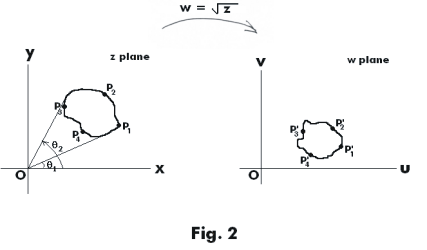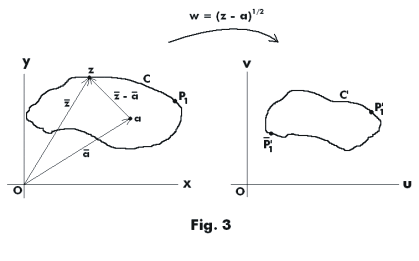
Website owner: James Miller
Multiple-valued functions, branch points, branch lines, Riemann surfaces
Multiple-valued functions, branch points, branch lines

Example 1. Suppose
we are given the function
w = z1/2 and ask
ourselves how this
function will map points
taken along curve C
which encircles the
origin as shown in Fig. 1. We pick points along the curve and let z make a complete circuit
(counterclockwise) around the origin. For insight into what is happening we express z as z = reiθ.
The image of z in the w plane is then given by w =
![]() eiθ/2. Thus each point P(r, θ) is mapped
into its image P'(
eiθ/2. Thus each point P(r, θ) is mapped
into its image P'(
![]() , θ/2). Point P1 (r1, θ1) is imaged into P1'(
, θ/2). Point P1 (r1, θ1) is imaged into P1'(
![]() , θ1/2). P2, P3 and P4 are imaged
into points P2', P3' and P4' as shown in the figure. Each point P is mapped into its image P' in the
w plane where P' has half the amplitude of P. We make a complete circuit around curve C and
arrive back at point P1 again. The amplitude of P1 is now θ = θ1 + 2π. Point P1(r1, θ1 + 2π) is
imaged into point
, θ1/2). P2, P3 and P4 are imaged
into points P2', P3' and P4' as shown in the figure. Each point P is mapped into its image P' in the
w plane where P' has half the amplitude of P. We make a complete circuit around curve C and
arrive back at point P1 again. The amplitude of P1 is now θ = θ1 + 2π. Point P1(r1, θ1 + 2π) is
imaged into point
![]() (r1, θ1/2 + π) shown in the figure in the third quadrant of the w plane, where
we are denoting the images of points from the second circuit around C with an over-bar. As we
continue points P2, P3
and P4 map into points
(r1, θ1/2 + π) shown in the figure in the third quadrant of the w plane, where
we are denoting the images of points from the second circuit around C with an over-bar. As we
continue points P2, P3
and P4 map into points
![]() and
and
![]() as
shown in the figure.
Finally we arrive at
point P1 for the third
time and the amplitude
is now θ = θ1 + 4π.
This time point P1 maps
into the same point that
it did on the first trip
through, point P1', and
the process starts over
again.
as
shown in the figure.
Finally we arrive at
point P1 for the third
time and the amplitude
is now θ = θ1 + 4π.
This time point P1 maps
into the same point that
it did on the first trip
through, point P1', and
the process starts over
again.

We can describe the above process by saying that if 0
![]() θ < 2π we are on one branch of
multiple-valued function z1/2, while if 2π
θ < 2π we are on one branch of
multiple-valued function z1/2, while if 2π
![]() θ < 4π we are on the other branch of the function.
θ < 4π we are on the other branch of the function.
The above phenomenon in which a point P on C maps into two points on C' occurs because curve C encircles the origin. If C did not encircle the origin it wouldn’t happen. A point on C would then map into a single point on C'. Let us consider this case. See Fig. 2. In Fig. 2 we see that the amplitude of z varies between θ1 and θ2. The amplitude of w will then vary between θ1/2 and θ2 /2. Point P1 will be mapped only into point P1', P2 will be mapped only into point P2', etc. The mapping is different and one-to-one.

Example 2. Let us now
consider how the function
w = (z - a)1/2 maps a
curve C that encircles
point a. See Fig. 3.
![]() is
the position vector to
point z on the curve.
is
the position vector to
point z on the curve.
![]() is
the position vector to
point a. As point z moves
counterclockwise around
curve C the vector
is
the position vector to
point a. As point z moves
counterclockwise around
curve C the vector
![]() ,
extending from point a to
z, winds around point a.
On the first trip around
the curve, point P1 is
mapped into point P1'. Assume the amplitude of the vector
,
extending from point a to
z, winds around point a.
On the first trip around
the curve, point P1 is
mapped into point P1'. Assume the amplitude of the vector
![]() is θ1 at P1. Note that arg w =
is θ1 at P1. Note that arg w =
![]() arg (z - a) so the amplitude of w will be θ1 /2. When z has made a complete circuit and arrives
at P1 the second time the amplitude of
arg (z - a) so the amplitude of w will be θ1 /2. When z has made a complete circuit and arrives
at P1 the second time the amplitude of
![]() will be θ1 + 2π and the amplitude of w will be θ1/2
+ π. P1 will map into
will be θ1 + 2π and the amplitude of w will be θ1/2
+ π. P1 will map into
![]() . When z proceeds on around the circuit again and arrives at P1 for the
third time, the amplitude of
. When z proceeds on around the circuit again and arrives at P1 for the
third time, the amplitude of
![]() will be 4π, the amplitude of w will be θ1 /2 + 2π, and P1 will
map into P1' again.
will be 4π, the amplitude of w will be θ1 /2 + 2π, and P1 will
map into P1' again.
Branch point. If different values of a function f(z) are obtained by successively encircling some point z0 in the complex plane, as occurred in examples 1 and 2 above, then the point z0 is called a branch point. In Example 1 the origin O is a branch point and in Example 2, the point a is a branch point.
A branch point represents a singularity of a multi-valued function, however, it has a different character from the points ordinarily called singular points.
Example 3. f(z) = (z - 2)1/3 has a branch point at z = 2.
Example 4. f(z) = ln (z2 + z - 6) has branch points where z2 + z - 6 = 0, i.e. at z = 2 and z = -3.
Branch line. A branch line is a line extending out from a branch point defining a boundary between branches. When a variable z crosses a branch line the function f(z) switches from one branch to another. The heavy line OX in Fig. 1 extending from the branch point O to infinity is a branch line.
Riemann surface. Let z0 be any complex number. How many complex numbers w will satisfy the equation w5 = z0? Answer: There are five different complex numbers that will satisfy this equation. If we pick any number z0 in the complex plane there are five different fifth roots of z0. Thus we say that the function w = z1/5 is a 5-value function. Five different numbers satisfy it. The function w = z1/5 associates with each point z in the complex plane five different numbers. Let us designate these five numbers as s1, s2, ... , s5. We can now conceive of five “sheets of values” overlaying the z plane, one stacked on top of another, going from Sheet 1 up to Sheet 5. The first sheet consists of the s1 numbers for all (x, y) number pairs in the plane i.e. all points of the plane. The second sheet consists of the s2 numbers for all (x, y) number pairs in the plane. Etc. for all five sheets. A function w = z1/2 has two sheets associated with it. A function w = z1/8 has eight sheets associated with it. The five sheets associated with the 5-value function w = z1/5 represent the five branches of the function. They represent the five sheets of a 5-sheet Riemann surface. The Riemann surface consists of a collection of five sheets where each sheet represents a single-valued function. The sheets in a Riemann surface are conceived of as connected to one another. To understand how they are connected consider the case of a 2-sheet Riemann surface where the branch point is the origin O as in Example 1 above. Imagine the two sheets, Sheet 1 and Sheet 2, overlaying the z plane. Now cut both sheets along OX and imagine that the lower edge of the bottom sheet is joined to the upper edge of the top sheet. Then starting in the bottom sheet and making one complete circuit around the branch point we arrive in the top sheet when we cross the branch line (or branch cut) OX. We must now imagine the other cut edges joined together so that by continuing the circuit we go from the top sheet back to the bottom sheet.
References
Spiegel. Complex Variables (Schaum)
Hauser. Complex Variables with Physical Applications
Jesus Christ and His Teachings
Way of enlightenment, wisdom, and understanding
America, a corrupt, depraved, shameless country
On integrity and the lack of it
The test of a person's Christianity is what he is
Ninety five percent of the problems that most people have come from personal foolishness
Liberalism, socialism and the modern welfare state
The desire to harm, a motivation for conduct
On Self-sufficient Country Living, Homesteading
Topically Arranged Proverbs, Precepts, Quotations. Common Sayings. Poor Richard's Almanac.
Theory on the Formation of Character
People are like radio tuners --- they pick out and listen to one wavelength and ignore the rest
Cause of Character Traits --- According to Aristotle
We are what we eat --- living under the discipline of a diet
Avoiding problems and trouble in life
Role of habit in formation of character
Personal attributes of the true Christian
What determines a person's character?
Love of God and love of virtue are closely united
Intellectual disparities among people and the power in good habits
Tools of Satan. Tactics and Tricks used by the Devil.
The Natural Way -- The Unnatural Way
Wisdom, Reason and Virtue are closely related
Knowledge is one thing, wisdom is another
My views on Christianity in America
The most important thing in life is understanding
We are all examples --- for good or for bad
Television --- spiritual poison
The Prime Mover that decides "What We Are"
Where do our outlooks, attitudes and values come from?
Sin is serious business. The punishment for it is real. Hell is real.
Self-imposed discipline and regimentation
Achieving happiness in life --- a matter of the right strategies
Self-control, self-restraint, self-discipline basic to so much in life
Website owner: James Miller